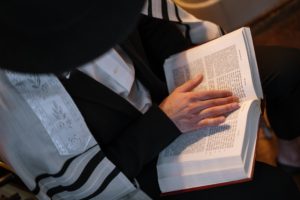On several occasions the Stick of Joseph refers to “unfolding” information, often in terms of revealing “the mysteries of Elohim”. The following are just a few examples:
For he that diligently seeks shall find, and the mysteries of Elohim shall be unfolded to them by the power of the Ruach HaKodesh, as well in this time as in times of old, and as well in times of old as in times to come; wherefore, the course of YHWH is one eternal round.
(1 Nefi 3:5), emphasis added
And now I, Ya’akov, am led on by the spirit unto prophesying, for I perceive by the workings of the spirit which is in me that by the stumbling of the Y’hudim, they will reject the stone upon which they might build and have safe foundation. But behold, according to the scriptures, this stone shall become the great, and the last, and the only sure foundation upon which the Y’hudim can build. And now my beloved, how is it possible that these, after having rejected the sure foundation, can ever build upon it that it may become the head of their corner? Behold, my beloved brothers, I will unfold this mystery unto you, if I do not by any means get shaken from my firmness in the spirit and stumble because of my overanxiety for you.
(Ya’akov 3:6), emphasis added
And these are the words which he spoke and caused to be written, saying, Mybrothers, all you that have assembled yourselves together, you that can hear my words which I shall speak unto you this day, for I have not commanded you to come up here to trifle with the words which I shall speak, but that you should hearken unto me, and open your ears that you may hear, and your hearts that you may understand, and your minds that the mysteries of Elohim may be unfolded to your view.
(Moshiyah 1:7), emphasis added
And now when Ammon had made an end of speaking these words, the king rejoiced exceedingly and gave thanks to Elohim, saying, Doubtless a great mystery is contained within these plates; and these interpreters were doubtless prepared for the purpose of unfolding all such mysteries to the children of men.
(Moshiyah 5:14), emphasis added
The Bible, by contrast, never refers to “unfolding” the mysteries of Elohim. One is left to wonder where this term came from and how it applies to divine learning. In the passages above, it’s clear that such mysteries are “unfolded” with the help of the Ruach HaKodesh (Holy Spirit) to all who seek with willing hearts and minds. But there’s also a more direct, literal application of this term in Jewish thought and scriptural practice.
We find reference to “unfolding” the mysteries of the Torah in the Zohar (quoting from the Soncino edition):
R. Simeon asked. ‘I weep’, he said, “because I think: Woe to the children of the world whose ways are the ways of beasts, without knowledge and understanding! It would have been better for them not to have been created. Woe to the world when thou, Master, wilt be removed from it! For who will then unfold the mysteries of the Torah? Who will then comprehend and grasp her ways?
(Zohar 2:89b), emphasis added
The Aramaic word that appears for “unfold” in the Zohar is גלאה which can also mean to “unroll” “manifest” or “reveal” something. In fact in Aramaic the Book of Revelation is called the Book of גלא.
Truly, the word “unfold” is a very appropriate word when considering scriptural meaning from the perspective of Jewish thought. One of the methods used by the Rabbis to of find hidden messages in the Scriptures is called Temurah, which involves letter substitutions. The simplest form of Temurah is called Atbash, which is based on a “decoder” key that is created by writing the 22 Hebrew letters and then “folding” them down the middle, so that the first letter is next to the last (alef א is next to tav ת) and the second letter is next to the second from last letter (beit ב is next to shin ש) etc; thus the name ATBASH אתבש.
A good example of ATBASH is used by Jeremiah (who was a contemporary of Lechi) in Jeremiah 25:26:
And all the kings of the north, far and near, one with another, and all the kingdoms of the world, which are upon the face of the earth: and the king of Sheshach shall drink after them.
(Jer. 25:26 KJV), emphasis added
Here Jeremiah used the king of “Sheshach” (ששך) as a code for the king of Babylon (בבל). The cipher allowed Jeremiah to conceal his true meaning where necessary while yet making it available to those who understood the use of the ATBASH cipher.
A similar instance occurs in Jeremiah 51:1 where “Leb Kamai” (לבקמי) substitutes for “Chaldea” (כשדים) in the ATBASH cipher. Decoding these hidden meanings entails “folding” the Hebrew alphabet in half, and deciphering ATBASH could be said to involve “unfolding” the letters.
Another example of “unfolding” scripture applies to the structural poetic arrangement known as “chiasmus.” This is a literary arrangement in which a series of ideas is repeated in reverse order. A simple example is “When the going gets tough, the tough get going.” The Hebrew Bible is replete with examples of chiasmus, both lengthy and brief. Consider the following from Proverbs:
The wicked worketh a deceitful work: but to him that soweth righteousness shall be a sure reward. As righteousness tendeth to life: so he that pursueth evil pursueth it to his own death.
Proverbs 11:18-19(KJV), emphasis added
Often, a chiasmus will include a central idea, located between the first series of ideas and the second series, given in reverse order. This central idea represents not only the theme of the chiasmus, but also the point at which the chiasmus can be folded over on itself to align the first and second series of parallel ideas.
Consider this example from Proverbs 6:16-19 (KJV), in which the ideas are noted with A, B, C, and the parallels, C’, B’ and A’. Note the central idea of the chiasmus is D:
These six things doth the LORD hate: yea, seven are an abomination unto him:
A. A proud look
B. a lying tongue
C. and hands that shed innocent blood,
D. An heart that deviseth wicked imaginations,
C’. feet that be swift in running to mischief
B’. A false witness that speaketh lies,
A’. and he that soweth discord among brethren.
The entire thought folds over on itself at the center point (D) and fully understanding the passage requires “unfolding” the meaning by considering the parallel ideas and their relationship to the center: Pride and discord, hands and feet, and wickedness in the heart.
Notably, the Stick of Joseph is replete with examples of chiasmus, just as the Bible. A complete study of the topic would quite literally fill volumes, but for our purposes here it’s only necessary to not the abundance of chiasmus found there.
Though the word “unfold” is never used in the King James Version of the Bible, it is indeed one fundamental and literal method of revealing mysteries hidden in scripture, and is reflective of Jewish thought in the minds of the Stick of Joseph writers. It is precisely the correct word to use when considering searching out the mysteries of Elohim in scripture.
Naturally, Yosef ben Yosef, the translator of the Stick of Joseph would not have known to use the word “unfold” to express both the idea and a literal method of revealing scriptural mysteries and hidden meanings. The repeated use of this word in the text is another hallmark of the text’s ancient Jewish authenticity.




Leave a Reply